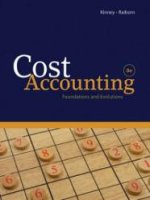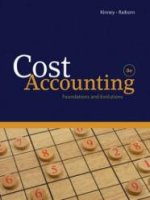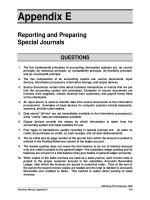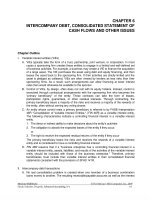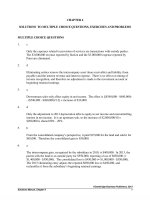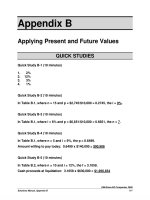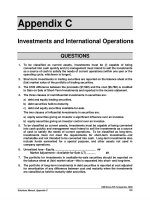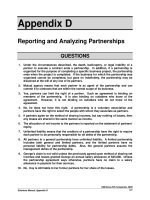Solution manual financial accounting 8e by libby ch06
Bạn đang xem bản rút gọn của tài liệu. Xem và tải ngay bản đầy đủ của tài liệu tại đây (995.97 KB, 40 trang )
Find more at www.downloadslide.com
Chapter 06 - Reporting and Interpreting Sales Revenue, Receivables, and Cash
Chapter 6
Reporting and Interpreting Sales Revenue,
Receivables, and Cash
ANSWERS TO QUESTIONS
1.
The difference between sales revenue and net sales includes the amount of
goods returned by customers because the goods were either unsatisfactory or
not desired, sales discounts given to business customers, and credit card fees
charged by credit card companies (also refer to the answers given below to
questions 3, 4 and 5).
2.
Gross profit or gross margin on sales is the difference between net sales and
cost of goods sold. For example, assuming sales of $100,000, and cost of goods
sold of $60,000, the gross profit on sales would be $40,000.
3.
A credit card discount is the fee charged by the credit card company for services.
When a company deposits its credit card receipts in the bank, it only receives
credit for the sales amount less the discount. The credit card discount account
either decreases net sales (it is a contra revenue) or increases selling expense.
4.
A sales discount is a discount given to customers for payment of accounts within
a specified short period of time. Sales discounts arise only when goods are sold
on credit and the seller extends credit terms that provide for a cash discount. For
example, the credit terms may be 1/10, n/30. These terms mean that if the
customer pays within 10 days, 1% can be deducted from the invoice price of the
goods. Alternatively, if payment is not made within the 10-day period, no discount
is permitted and the total invoice amount is due within 30 days from the
purchase, after which the debt is past due. To illustrate, assume a $1,000 sale
with these terms. If the customer paid within 10 days, $990 would have been
paid. Thus, a sales discount of $10 was granted for early payment.
Financial Accounting, 8/e
6-1
© 2014 by McGraw-Hill Global Education Holdings, LLC. This is proprietary material solely for authorized instructor use. Not authorized for sale or distribution in
any manner. This document may not be copied, scanned, duplicated, forwarded, distributed, or posted on a website, in whole or part.
Find more at www.downloadslide.com
Chapter 06 - Reporting and Interpreting Sales Revenue, Receivables, and Cash
5.
A sales allowance is an amount allowed to a customer for unsatisfactory
merchandise or for an overcharge in the sales price. A sales allowance reduces
the amount the customer must pay, or if already paid, a cash refund is required.
Sales allowances may occur whether the sale was for cash or credit. In contrast,
a sales discount is a cash discount given to a customer who has bought on
credit, with payment made within the specified period of time. (Refer to
explanation of sales discount in Question 4, above.)
6.
An account receivable is an amount owed to the business on open account by a
trade customer for merchandise or services purchased. In contrast, a note
receivable is a short-term obligation owed to the company based on a formal
written document.
7.
In conformity with the expense matching principle, the allowance method records
bad debt expense in the same period in which the credit was granted and the
sale was made.
8.
Using the allowance method, bad debt expense is recognized in the period in
which the sale related to the uncollectible account was recorded.
9.
The write-off of bad debts using the allowance method decreases the asset
accounts receivable and the contra-asset allowance for doubtful accounts by the
same amount. As a consequence, (a) net income is unaffected and (b) accounts
receivable, net, is unaffected.
10.
An increase in the receivables turnover ratio generally indicates faster collection
of receivables. A higher receivables turnover ratio reflects an increase in the
number of times average trade receivables were recorded and collected during
the period.
11.
Cash includes money and any instrument, such as a check, money order, or
bank draft, which banks normally will accept for deposit and immediate credit to
the depositor’s account. Cash equivalents are short-term investments with
original maturities of three months or less that are readily convertible to cash,
and whose value is unlikely to change (e.g., bank certificates of deposit and
treasury bills).
12.
The primary characteristics of an internal control system for cash are: (a)
separation of the functions of cash receiving from cash payments, (b) separation
of accounting for cash receiving and cash paying, (c) separation of the physical
handling of cash from the accounting function, (d) deposit all cash receipts daily
and make all cash payments by check, (e) require separate approval of all
checks and electronic funds transfers, and (f) require monthly reconciliation of
bank accounts.
6-2
Solutions Manual
© 2014 by McGraw-Hill Global Education Holdings, LLC. This is proprietary material solely for authorized instructor use. Not authorized for sale or distribution in
any manner. This document may not be copied, scanned, duplicated, forwarded, distributed, or posted on a website, in whole or part.
Find more at www.downloadslide.com
Chapter 06 - Reporting and Interpreting Sales Revenue, Receivables, and Cash
13.
Cash-handling and cash-recording activities should be separated to remove the
opportunity for theft of cash and a cover-up by altering the records. This
separation is accomplished best by assigning the responsibility for cash handling
to individuals other than those who have the responsibility for record-keeping. In
fact, it usually is desirable that these two functions be performed in different
departments of the business.
14.
The purposes of a bank reconciliation are (a) to determine the ―true‖ cash
balance and (b) to provide data to adjust the Cash account to that balance. A
bank reconciliation involves reconciling the balance in the Cash account at the
end of the period with the balance shown on the bank statement (which is not the
―true‖ cash balance) at the end of that same period. Seldom will these two
balances be identical because of such items as deposits in transit; that is,
deposits that have been made by the company but not yet entered on the bank
statement. Another cause of the difference is outstanding checks, that is, checks
that have been written and recorded in the accounts of the company that have
not cleared the bank (and thus have not been deducted from the bank's balance).
Usually the reconciliation of the two balances, per books against per bank,
requires recording of one or more items that are reflected on the bank statement
but have not been recorded in the accounting records of the company. An
example is the usual bank service charge.
15.
The total amount of cash that should be reported on the balance sheet is the
sum of (a) the true cash balances in all checking accounts (verified by a bank
reconciliation of each checking account), (b) cash held in all ―cash on hand‖ (or
―petty cash‖) funds, and (c) any cash physically on hand (any cash not
transferred to a bank for deposit—usually cash held for change purposes).
16.
(Chapter Supplement) Under the gross method of recording sales discounts, the
amount of sales discount taken is recorded at the time the collection of the
account is recorded.
ANSWERS TO MULTIPLE CHOICE
1. b)
6. c)
Financial Accounting, 8/e
2. c)
7. d)
3. b)
8. b)
4. d)
9. d)
5. c)
10. c)
6-3
© 2014 by McGraw-Hill Global Education Holdings, LLC. This is proprietary material solely for authorized instructor use. Not authorized for sale or distribution in
any manner. This document may not be copied, scanned, duplicated, forwarded, distributed, or posted on a website, in whole or part.
Find more at www.downloadslide.com
Chapter 06 - Reporting and Interpreting Sales Revenue, Receivables, and Cash
Authors' Recommended Solution Time
(Time in minutes)
Mini-exercises
No.
Time
1
5
2
5
3
10
4
10
5
10
6
10
7
5
8
10
Exercises
No.
Time
1
15
2
15
3
15
4
20
5
20
6
15
7
15
8
15
9
15
10
15
11
20
12
20
13
20
14
20
15
20
16
30
17
30
18
15
19
15
20
20
21
20
22
20
23
30
24
30
Problems
No.
Time
1
25
2
35
3
35
4
50
5
40
6
45
7
45
8
45
Alternate
Problems
No.
Time
1
35
2
35
3
50
4
40
5
45
Cases and
Projects
No.
Time
1
25
2
30
3
35
4
20
5
35
6
45
7
*
Continuing Case
1
30
* Due to the nature of these cases and projects, it is very difficult to estimate the amount
of time students will need to complete the assignment. As with any open-ended project,
it is possible for students to devote a large amount of time to these assignments. While
students often benefit from the extra effort, we find that some become frustrated by the
perceived difficulty of the task. You can reduce student frustration and anxiety by
making your expectations clear. For example, when our goal is to sharpen research
skills, we devote class time to discussing research strategies. When we want the
students to focus on a real accounting issue, we offer suggestions about possible
companies or industries.
6-4
Solutions Manual
© 2014 by McGraw-Hill Global Education Holdings, LLC. This is proprietary material solely for authorized instructor use. Not authorized for sale or distribution in
any manner. This document may not be copied, scanned, duplicated, forwarded, distributed, or posted on a website, in whole or part.
Find more at www.downloadslide.com
Chapter 06 - Reporting and Interpreting Sales Revenue, Receivables, and Cash
MINI-EXERCISES
M6–1.
Transaction
(a) Sale of inventory to a business
x
customer on open account
(b) Computer sold by mail order
x
company on a credit card
(c) Airline tickets sold by an airline on a
credit card
Point A
Point B
Shipment
Collection of account
Shipment
Delivery
Point of sale
x Completion of flight
M6–2.
If the buyer pays within the discount period, the income statement will report $9,405 as
net sales ($9,500 x 0.99).
M6–3.
Credit card sales (R)
Less: Credit card discount (XR)
Net credit card sales
Sales on account (R)
Less: Sales returns (XR)
Less: Sales discounts (1/2 x $11,350 x 2%) (XR)
Net sales on account
Net sales (reported on income statement)
Financial Accounting, 8/e
$9,400.00
282.00
$9,118.00
$12,000.00
650.00
11,350.00
113.50
11,236.50
$20,354.50
6-5
© 2014 by McGraw-Hill Global Education Holdings, LLC. This is proprietary material solely for authorized instructor use. Not authorized for sale or distribution in
any manner. This document may not be copied, scanned, duplicated, forwarded, distributed, or posted on a website, in whole or part.
Find more at www.downloadslide.com
Chapter 06 - Reporting and Interpreting Sales Revenue, Receivables, and Cash
M6–4.
(a)
(b)
Allowance for doubtful accounts (–XA, +A) .............. 14,500
Accounts receivable (–A) ..................................
To write off specific bad debts.
14,500
Bad debt expense (+E, –SE) ..................................... 16,000
Allowance for doubtful accounts (+XA, –A) .......
To record estimated bad debt expense.
16,000
M6–5.
Assets
Liabilities
(a) Allowance for doubtful
accounts
–15,000
(b) Allowance for doubtful
accounts
Accounts receivable
Stockholders’ Equity
Bad debt expense –15,000
+9,500
–9,500
M6–6.
+
+
–
(a) Granted credit with shorter payment deadlines.
(b) Increased effectiveness of collection methods.
(c) Granted credit to less creditworthy customers.
M6–7.
Reconciling Item
(a) Outstanding checks
(b) Bank service charge
(c) Deposit in transit
Company’s
Bank
Books
Statement
–
–
+
M6–8. (Supplement)
A $6,000 credit sale with terms, 3/10, n/30, should be recorded as follows:
Accounts receivable (+A) ............................................ 6,000
Sales revenue (+R, +SE) .................................
6,000
This entry records the sale at the gross amount. If the customer does pay within the
discount period, only $5,820 must be paid, in which case the entry for payment would
be as follows:
Cash (+A) ................................................................... 5,820
Sales discounts (+XR, –R, –SE) .................................
180
Accounts receivable (–A) .................................
6,000
6-6
Solutions Manual
© 2014 by McGraw-Hill Global Education Holdings, LLC. This is proprietary material solely for authorized instructor use. Not authorized for sale or distribution in
any manner. This document may not be copied, scanned, duplicated, forwarded, distributed, or posted on a website, in whole or part.
Find more at www.downloadslide.com
Chapter 06 - Reporting and Interpreting Sales Revenue, Receivables, and Cash
EXERCISES
E6–1.
Sales revenue ($1,500 + $850 + $500) ....................................
Less: Sales discount ($1,500 collected from S. Green x 2%) ..
Net sales ..................................................................................
$2,850
30
$2,820
Sales revenue ($3,000 + $9,000 +$4,000) ...............................
Less: Sales discounts ($9,000 collected from S x 3%) ............
Less: Credit card discounts ($3,000 from R x 2%)...................
Net sales ..................................................................................
$16,000
270
60
$15,670
Sales revenue ($5,500 + $400 + $9,000) .................................
Less: Sales returns and allowances (1/10 x $9,000 from D) .......
Less: Sales discounts (9/10 x $9,000 from D x 3%) ...................
Less: Credit card discounts ($400 from C x 2%) .......................
Net sales .............................................................................
$14,900
900
243
8
$13,749
E6–2.
E6–3.
E6–4.
Transaction
July 12
July 15
July 20
July 21
Net Sales
+ 297
+ 5,000
– 150
– 1,000
Cost of
Goods Sold
+ 175
+ 2,500
NE
– 600
Gross Profit
+ 122
+ 2,500
– 150
– 400
E6–5.
Req. 1
(Amount saved ÷ Amount paid) = Interest rate for 40 days.
(3% ÷ 97%) = 3.09% for 40 days.
Interest rate for 40 days x (365 days ÷ 40 days) = Annual interest rate
3.09% x (365 ÷ 40 days) = 28.22%
Req. 2
Yes, because the 15% rate charged by the bank is less than the 28.22%
rate implicit in the discount. The customer will earn 13.22% by doing so (28.22%
– 15%).
Financial Accounting, 8/e
6-7
© 2014 by McGraw-Hill Global Education Holdings, LLC. This is proprietary material solely for authorized instructor use. Not authorized for sale or distribution in
any manner. This document may not be copied, scanned, duplicated, forwarded, distributed, or posted on a website, in whole or part.
Find more at www.downloadslide.com
Chapter 06 - Reporting and Interpreting Sales Revenue, Receivables, and Cash
E6–6.
(a)
(b)
E6–7.
(a)
(b)
Bad debt expense (+E, –SE) ($1,300,000 x 0.01) ..... 13,000
Allowance for doubtful accounts (+XA, –A) .......
To record estimated bad debt expense.
13,000
Allowance for doubtful accounts (–XA, +A) .............. 4,000
Accounts receivable (–A) ..................................
To write off a specific bad debt.
4,000
Bad debt expense (+E, –SE) ($5,000,000 x 0.02) ..... 100,000
Allowance for doubtful accounts (+XA, –A) .......
To record estimated bad debt expense.
100,000
Allowance for doubtful accounts (–XA, +A) .............. 98,000
Accounts receivable (–A) ..................................
To write off a specific bad debt.
98,000
E6–8.
Assets
Liabilities
Stockholders’ Equity
Bad debt expense –100,000
(a) Allowance for doubtful
accounts
–100,000
(b) Allowance for doubtful
accounts
+98,000
Accounts receivable
E6–9.
Req. 1
(a)
(b)
–98,000
Bad debt expense (+E, –SE) ($680,000 x 0.035) ...... 23,800
Allowance for doubtful accounts (+XA, –A) .......
To record estimated bad debt expense.
23,800
Allowance for doubtful accounts (–XA, +A) .............. 2,800
Accounts receivable (–A) ..................................
To write off a specific bad debt.
2,800
Req. 2
Transaction
a.
b.
6-8
Net Sales
NE
NE
Gross Profit
NE
NE
Income from
Operations
– 23,800
NE
Solutions Manual
© 2014 by McGraw-Hill Global Education Holdings, LLC. This is proprietary material solely for authorized instructor use. Not authorized for sale or distribution in
any manner. This document may not be copied, scanned, duplicated, forwarded, distributed, or posted on a website, in whole or part.
Find more at www.downloadslide.com
Chapter 06 - Reporting and Interpreting Sales Revenue, Receivables, and Cash
E6–10.
Estimated
Estimated
percentage
amount
Aged accounts receivable
uncollectible
uncollectible
Not yet due
$22,000 x
3%
=
$ 660
Up to 120 days past due
6,500 x
14%
=
910
Over 120 days past due
2,800 x
34%
=
952
Estimated balance in Allowance for Doubtful Accounts
2,522
Current balance in Allowance for Doubtful Accounts
1,200
Bad Debt Expense for the year
$1,322
E6–11.
Req. 1
December 31, 2013-Adjusting entry:
Bad debt expense (+E, –SE) ....................................... 4,180
Allowance for doubtful accounts (+XA, –A) .......
4,180
To adjust for estimated bad debt expense for 2013 computed as follows:
Estimated
Estimated
percentage
amount
Aged accounts receivable
uncollectible
uncollectible
Not yet due
$50,000 x
3%
=
$ 1,500
Up to 180 days past due
14,000 x
12%
=
1,680
Over 180 days past due
4,000 x
30%
=
1,200
Estimated balance in Allowance for Doubtful Accounts
4,380
Current balance in Allowance for Doubtful Accounts
200
Bad Debt Expense for the year
$4,180
Req. 2
Balance sheet:
Accounts receivable ($50,000 + $14,000 + $4,000)
Less allowance for doubtful accounts .....................
Accounts receivable, net of allowance for
doubtful accounts.........................................
Financial Accounting, 8/e
$68,000
4,380
$63,620
6-9
© 2014 by McGraw-Hill Global Education Holdings, LLC. This is proprietary material solely for authorized instructor use. Not authorized for sale or distribution in
any manner. This document may not be copied, scanned, duplicated, forwarded, distributed, or posted on a website, in whole or part.
Find more at www.downloadslide.com
Chapter 06 - Reporting and Interpreting Sales Revenue, Receivables, and Cash
E6–12.
Req. 1
December 31, 2015-Adjusting entry:
Bad debt expense (+E, –SE) ....................................... 18,725
Allowance for doubtful accounts (+XA, –A) .......
18,725
To adjust for estimated bad debt expense for 2015 computed as follows:
Estimated
Estimated
percentage
amount
Aged accounts receivable
uncollectible
uncollectible
Not yet due
$295,000 x
2.5%
=
$7,375
Up to 120 days past due
55,000 x
11%
=
6,050
Over 120 days past due
18,000 x
30%
=
5,400
Estimated balance in Allowance for Doubtful Accounts
18,825
Current balance in Allowance for Doubtful Accounts
100
Bad Debt Expense for the year
$18,725
Req. 2
Balance sheet:
Accounts receivable ($295,000 + $55,000 + $18,000)
Less allowance for doubtful accounts .....................
Accounts receivable, net of allowance for
doubtful accounts.........................................
$368,000
18,825
$349,175
E6–13.
1.
2.
6-10
Bad debt expense (+E, –SE) ................................................. 213
Allowance for doubtful accounts (+XA, –A) ..................
To record estimated bad debt expense.
213
Allowance for doubtful accounts (–XA, +A)............................. 201
Accounts receivable (–A) .............................................
To write off specific bad debts.
201
It would have no effect because the asset ―Accounts receivable‖ and contraasset ―Allowance for doubtful accounts‖ would both decline by Euro 10 million.
Neither ―Receivables, net‖ nor ―Net income‖ would be affected.
Solutions Manual
© 2014 by McGraw-Hill Global Education Holdings, LLC. This is proprietary material solely for authorized instructor use. Not authorized for sale or distribution in
any manner. This document may not be copied, scanned, duplicated, forwarded, distributed, or posted on a website, in whole or part.
Find more at www.downloadslide.com
Chapter 06 - Reporting and Interpreting Sales Revenue, Receivables, and Cash
E6–14.
Req. 1
Allowance for Doubtful Accounts
Write-offs
52
117
88
Beg. balance
Bad debt exp.
153
End. balance
Beg. Balance + Bad debt exp. – Write-offs = End. Balance
Beg. Balance + Bad debt exp. – End. Balance = Write-offs
117 + 88 – 153 = 52
Bad debt expense increases (is credited to) the allowance. Since we are given
the beginning and ending balances in the allowance, we can solve for write-offs,
which decrease (are debited to) the allowance.
Req. 2
Accounts Receivable (Gross)
Beg. balance*
Net sales
11,455
60,420
End. balance **
13,742
52
58,081
Write-offs
Cash collections
* 11,338 + 117
** 13,589 + 153
Beg. balance + Net sales – Write-offs – Cash collections = End. Balance
Beg. balance + Net sales – Write-offs – End. Balance = Cash collections
11,455 + 60,420 – 52 – 13,742 = 58,081
Accounts receivable gross is increased by recording credit sales and decreased
by recording cash collections and write-offs of bad debts. Thus, we can solve for
cash collections as the missing value.
Financial Accounting, 8/e
6-11
© 2014 by McGraw-Hill Global Education Holdings, LLC. This is proprietary material solely for authorized instructor use. Not authorized for sale or distribution in
any manner. This document may not be copied, scanned, duplicated, forwarded, distributed, or posted on a website, in whole or part.
Find more at www.downloadslide.com
Chapter 06 - Reporting and Interpreting Sales Revenue, Receivables, and Cash
E6–15.
Req. 1
Allowance for Doubtful Accounts
Write-offs
56
375
14
Beg. balance
Bad debt exp.
333
End. balance
Beg. Balance + Bad debt exp. – Write-offs = End. Balance
Beg. Balance + Bad debt exp. – End. Balance = Write-offs
375 + 14 – 333 = 56
Bad debt expense increases (is credited to) the allowance. Since we are given
the beginning and ending balances in the allowance, we can solve for write-offs,
which decrease (are debited to) the allowance.
Req. 2
Accounts Receivable (Gross)
Beg. balance*
Net sales
13,389
69,943
End. balance **
15,320
56
67,956
Write-offs
Cash collections
* 13,014 + 375
** 14,987 + 333
Beg. balance + Net sales – Write-offs – Cash collections = End. Balance
Beg. balance + Net sales – Write-offs – End. Balance = Cash collections
13,389 + 69,943 – 56 – 15,320 = 67,956
Accounts receivable gross is increased by recording credit sales and decreased
by recording cash collections and write-offs of bad debts. Thus, we can solve for
cash collections as the missing value.
6-12
Solutions Manual
© 2014 by McGraw-Hill Global Education Holdings, LLC. This is proprietary material solely for authorized instructor use. Not authorized for sale or distribution in
any manner. This document may not be copied, scanned, duplicated, forwarded, distributed, or posted on a website, in whole or part.
Find more at www.downloadslide.com
Chapter 06 - Reporting and Interpreting Sales Revenue, Receivables, and Cash
E6–16.
Req. 1
The allowance for doubtful accounts is increased (credited) when bad debt expense is
recorded and decreased (debited) when uncollectible accounts are written off. This case
gives the beginning and ending balances of the allowance account and the amount of
uncollectible accounts that were written off. Therefore, the amount of bad debt expense
(in thousands) can be computed as follows:
Allowance for Doubtful Accounts
Write-offs
414,000
690,000
154,000
Beg. balance
Bad debt exp.
430,000
End. balance
Beg. Balance + Bad debt exp. – Write-offs = End. Balance
End. Balance – Beg. Balance + Write-offs = Bad debt exp.
430,000– 690,000 + 414,000 = 154,000
Req. 2
Working capital is unaffected by the write-off of an uncollectible account when the
allowance method is used. The asset account (accounts receivable) and the contraasset account (allowance for doubtful accounts) are both reduced by the same amount;
therefore, the book value of net accounts receivable is unchanged.
Working capital is decreased when bad debt expense is recorded because the contraasset account (allowance for doubtful accounts) is increased. From requirement (1), we
know that net accounts receivable was reduced by $154,000 when bad debt expense
was recorded in year 2, reducing working capital by $154,000.
Note that income before taxes was reduced by the amount of bad debt expense that
was recorded, therefore tax expense and tax payable will decrease. The decrease in
tax payable caused working capital to increase; therefore, the net decrease was
$154,000 – ($154,000 x 30%) = $107,800.
Req. 3
The entry to record the write-off of an uncollectible account did not affect any income
statement accounts; therefore, net income is unaffected by the $414,000 write-off in
year 2.
The recording of bad debt expense reduced income before taxes in year 2 by $154,000
and reduced tax expense by $46,200 (i.e., $154,000 x 30%). Therefore, year 2 net
income was reduced by $107,800 (as computed in Req. 2).
Financial Accounting, 8/e
6-13
© 2014 by McGraw-Hill Global Education Holdings, LLC. This is proprietary material solely for authorized instructor use. Not authorized for sale or distribution in
any manner. This document may not be copied, scanned, duplicated, forwarded, distributed, or posted on a website, in whole or part.
Find more at www.downloadslide.com
Chapter 06 - Reporting and Interpreting Sales Revenue, Receivables, and Cash
E6–17.
Req. 1
Dec. 31, 2014
Allowance for doubtful accounts (–XA, +A)...............
Accounts receivable (J. Doe) (–A) .................
To write off an account receivable determined to
be uncollectible.
Dec. 31, 2014
Bad debt expense (+E, –SE) ...................................
Allowance for doubtful accounts (+XA, –A) ....
Adjusting entry--estimated loss on uncollectible
accounts; based on credit sales ($75,000 x 1.5%
= $1,125).
1,700
1,700
1,125
1,125
Req. 2
Income statement:
Operating expenses:
Bad debt expense ........................................................
Balance sheet:
Current assets
Accounts receivable ($16,000 + $75,000
- $60,000 - $1,700) .....................................
Less: Allowance for doubtful accounts
($900 - $1,700 + $1,125) ............................
$1,125
$29,300
325
$28,975
Req. 3
The 1.5% rate on credit sales may be too low because it resulted in bad debt expense only
two-thirds the amount of receivables written off ($1,700) during the year. However, if the
uncollectible account receivable written off during 2014 is not indicative of average
uncollectibles written off over a period of time, the 1.5% rate may be appropriate. There is
not sufficient historical data to make a definitive decision.
6-14
Solutions Manual
© 2014 by McGraw-Hill Global Education Holdings, LLC. This is proprietary material solely for authorized instructor use. Not authorized for sale or distribution in
any manner. This document may not be copied, scanned, duplicated, forwarded, distributed, or posted on a website, in whole or part.
Find more at www.downloadslide.com
Chapter 06 - Reporting and Interpreting Sales Revenue, Receivables, and Cash
E6–18.
Req. 1
Dec. 31, 2014
Allowance for doubtful accounts (–XA, +A)...............
Accounts receivable (Toby’s Gift Shop) (–A)..
To write off an account receivable determined to
be uncollectible.
Dec. 31, 2014
Bad debt expense (+E, –SE) ...................................
Allowance for doubtful accounts (+XA, –A) ....
Adjusting entry--estimated loss on uncollectible
accounts; based on credit sales ($25,000 x 2%
= $500).
550
550
500
500
Req. 2
Income statement:
Operating expenses:
Bad debt expense ........................................................
Balance sheet:
Current assets
Accounts receivable ($3,500 + $25,000
- $18,000 - $550) ........................................
Less: Allowance for doubtful accounts
($300 - $550 + $500) ..................................
$500
$9,950
250
$9,700
Req. 3
The 2% rate on credit sales appears reasonable because it approximates the amount of
receivables written off ($550) during the year. However, if the uncollectible account
receivable written off during 2014 is not indicative of average uncollectibles written off over
a period of time, the 2% rate may not be appropriate. There is not sufficient historical data
to make a definitive decision.
Financial Accounting, 8/e
6-15
© 2014 by McGraw-Hill Global Education Holdings, LLC. This is proprietary material solely for authorized instructor use. Not authorized for sale or distribution in
any manner. This document may not be copied, scanned, duplicated, forwarded, distributed, or posted on a website, in whole or part.
Find more at www.downloadslide.com
Chapter 06 - Reporting and Interpreting Sales Revenue, Receivables, and Cash
E6–19.
Req. 1
Receivables turnover =
Net Sales
= $39,304,000 = 8.99 times
Average Net Trade
$4,372,000*
Accounts Receivable
Average days sales
in receivables
365
= 365 = 40.60 days
Receivables Turnover
8.99
=
* ($4,163,000 + $4,581,000) ÷ 2
Req. 2
The receivables turnover ratio reflects how many times average trade receivables were
recorded and collected during the period. The average days sales in receivables
indicates the average time it takes a customer to pay its account.
E6–20.
Req. 1
Receivables turnover =
Net Sales
= $62,071,000 = 9.5722 times
Average Net Trade
$6,484,500*
Accounts Receivable
Average days sales
in receivables
365
= 365 = 38.13 days
Receivables Turnover 9.5722
=
* ($6,493,000 + $6,476,000) ÷ 2
Req. 2
The receivables turnover ratio reflects how many times average trade receivables were
recorded and collected during the period. The average days sales in receivables
indicates the average time it takes a customer to pay its account.
6-16
Solutions Manual
© 2014 by McGraw-Hill Global Education Holdings, LLC. This is proprietary material solely for authorized instructor use. Not authorized for sale or distribution in
any manner. This document may not be copied, scanned, duplicated, forwarded, distributed, or posted on a website, in whole or part.
Find more at www.downloadslide.com
Chapter 06 - Reporting and Interpreting Sales Revenue, Receivables, and Cash
E6–21.
Req. 1
The change in the accounts receivable balance ($48,066 – 63,403 = –$15,337) would
increase cash flow from operations by $15,337 thousand. This happens because the
Company is collecting cash faster than it is recording credit sales revenue.
Req. 2
(a) Declining sales revenue leads to lower accounts receivable because fewer new
credit sales are available to replace the receivables that are being collected.
(b) Cash collections from the prior period's higher credit sales are greater than the new
credit sales revenue. Note that in the next period, cash collections will also decline.
E6–22.
Req. 1
JACKSON COMPANY
Bank Reconciliation, June 30, 2014
Company's Books
Ending balance per Cash
account………………………
Additions:
None
Deductions:
Bank service charge……
Correct cash balance………
$5,600
40
$5,560
Bank Statement
Ending balance per bank
statement………………
Additions:
Deposit in transit…………
$6,060
1,900*
7,960
Deductions:
Outstanding checks…
Correct cash balance……
2,400
$5,560
*$18,100 – $16,200 = $1,900.
Req. 2
Bank service charge expense (+E, –SE) ..................................
Cash (–A) ......................................................................
To record deduction from bank account for service charges.
40
40
Req. 3
The correct cash balance per the bank reconciliation ($5,600 – $40), $5,560
Req. 4
Balance sheet (June 30, 2014):
Current assets:
Cash ..................................................................................
Financial Accounting, 8/e
$5,560
6-17
© 2014 by McGraw-Hill Global Education Holdings, LLC. This is proprietary material solely for authorized instructor use. Not authorized for sale or distribution in
any manner. This document may not be copied, scanned, duplicated, forwarded, distributed, or posted on a website, in whole or part.
Find more at www.downloadslide.com
Chapter 06 - Reporting and Interpreting Sales Revenue, Receivables, and Cash
E6–23.
Req. 1
BENNETT COMPANY
Bank Reconciliation, September 30, 2014
Company's Books
Ending balance per Cash
account ..........................
$5,700
Bank Statement
Ending balance per bank
statement .......................
Additions:
None
Additions:
Deposit in transit*.........
Deductions:
Bank service charges ...
NSF check –
Betty Brown .............
Deductions:
$5,770
1,200*
6,970
$ 60
170
Correct cash balance .......
230
$5,470
Outstanding checks
($28,900 – $27,400) ....
Correct cash balance .......
1,500
$5,470
*$28,100 - $26,900 = $1,200.
Req. 2
(1)
(2)
Bank service charge expense (+E, –SE) ................................
Cash (–A) ....................................................................
To record bank service charges deducted from bank balance.
60
Accounts receivable (Betty Brown) (+A) ................................. 170
Cash (–A) ....................................................................
To record customer check returned due to insufficient funds.
60
170
Req. 3
Same as the correct balance on the reconciliation, $5,470.
Req. 4
Balance Sheet (September 30, 2014):
Current Assets:
Cash ......................................................................................... $5,470
6-18
Solutions Manual
© 2014 by McGraw-Hill Global Education Holdings, LLC. This is proprietary material solely for authorized instructor use. Not authorized for sale or distribution in
any manner. This document may not be copied, scanned, duplicated, forwarded, distributed, or posted on a website, in whole or part.
Find more at www.downloadslide.com
Chapter 06 - Reporting and Interpreting Sales Revenue, Receivables, and Cash
E6–24 (Based on Supplement A)
November 20, 2013
Cash (+A) ....................................................................
Credit card discount (+XR, –R, –SE) ...........................
Sales revenue (+R, +SE) ..................................
To record credit card sale.
November 25, 2013:
Accounts receivable (Customer C) (+A) ......................
Sales revenue (+R, +SE) ..................................
To record a credit sale.
November 28, 2013:
Accounts receivable (Customer D) (+A) ......................
Sales revenue (+R, +SE) ..................................
To record a credit sale.
441
9
450
2,800
2,800
7,200
7,200
November 30, 2013:
Sales returns and allowances (+XR, –R, –SE) ............
600
Accounts receivable (Customer D) (–A) ............
To record return of defective goods, $7,200 x 1/12 = $600.
December 6, 2013:
Cash (+A) ....................................................................
Sales discounts (+XR, –R, –SE) ..................................
Accounts receivable (Customer D) (–A) ............
To record collection within the discount period,
98% × ($7,200 – $600) = $6,468
December 30, 2013:
Cash (+A) ....................................................................
Accounts receivable (Customer C) (–A) ............
To record collection after the discount period.
6,468
132
6,600
2,800
Sales revenue ($450 + $2,800 + $7,200) .................................
Less: Sales returns and allowances ($7,200 x 1/12).................
Less: Sales discounts (2% × ($7,200 – $600)) .........................
Less: Credit card discounts ($450 x 2%) ..................................
Net sales ..................................................................................
Financial Accounting, 8/e
600
2,800
$10,450
600
132
9
$9,709
6-19
© 2014 by McGraw-Hill Global Education Holdings, LLC. This is proprietary material solely for authorized instructor use. Not authorized for sale or distribution in
any manner. This document may not be copied, scanned, duplicated, forwarded, distributed, or posted on a website, in whole or part.
Find more at www.downloadslide.com
Chapter 06 - Reporting and Interpreting Sales Revenue, Receivables, and Cash
PROBLEMS
P6–1.
Case A
Because Wendy's collects cash when the coupon books are sold, cash collection is not
an issue in this case. In order to determine if the revenue has been earned, the student
must be careful in analyzing what Wendy's actually sold. Students who focus on the
sale of the coupon book often conclude that the earning process is complete with the
delivery of the book to the customer. In reality, Wendy's has a significant additional
service to perform; it has to serve a meal. The correct point for revenue recognition in
this case is when the customer uses the coupon or when the coupon expires and
Wendy's has no further obligation.
Case B
In this case there is an extremely low down payment and some reason to believe that
Uptown Builders may default on the contract because of prior actions. If students
believe that Russell Land Development could sue and collect on the contract, they will
probably argue for revenue recognition. Given the risk of cash collection, most students
will argue that revenue should be recognized as cash is collected. The text does not
discuss FASB #66 (ASC 360-20-40), but the instructor may want to mention during the
discussion that there is authoritative guidance concerning minimum down payments
before revenue can be recorded on a land sale.
Case C
While warranty work on refrigerators can involve significant amounts of effort and
money, companies are permitted to record revenue at the point of sale. The text does
not discuss this specific issue, but the matching concept is mentioned in the context of
revenue and expense recognition. This is an excellent opportunity to mention the need
to accrue estimated warranty expense at the time that sales revenue is recorded. Some
students are surprised to see that costs that will be incurred in the future can be
recorded as an expense in the current accounting period.
6-20
Solutions Manual
© 2014 by McGraw-Hill Global Education Holdings, LLC. This is proprietary material solely for authorized instructor use. Not authorized for sale or distribution in
any manner. This document may not be copied, scanned, duplicated, forwarded, distributed, or posted on a website, in whole or part.
Find more at www.downloadslide.com
Chapter 06 - Reporting and Interpreting Sales Revenue, Receivables, and Cash
P6–2.
Req. 1
(a)
(b)
(c)
(d)
(e)
(f)
(g)
(h)
(i)
(j)
(k)
(l)
(m)
Total
Sales
Revenue
+235,000
+11,500
+26,500
NE
+24,000
NE
NE
NE
+19,000
NE
NE
NE
NE
+$316,000
Sales Discounts
(taken)
NE
NE
NE
NE
NE
+220
+2,000*
+530
NE
–70
NE
NE
NE
+$2,680
Sales Returns
and Allowances
NE
NE
NE
+500
NE
NE
NE
NE
NE
+3,500
NE
NE
NE
+$4,000
Bad Debt
Expense
NE
NE
NE
NE
NE
NE
NE
NE
NE
NE
NE
NE
+1,155**
+$1,155
*$98,000 ÷ (1 ─ .02) = $100,000 gross sales; $100,000 x .02 = $2,000
**Credit sales ($11,500 + $26,500 + $24,000 + $19,000).. $81,000
Less: Sales returns ($500 + $3,500) .............................
4,000
Net sales revenue ..........................................................
77,000
Estimated bad debt rate ................................................. x
1.5%
Bad debt expense ..........................................................
$1,155
Req. 2
Income statement:
Sales revenue ........................................................... $316,000
Less: Sales returns and allowances ..............
4,000
Sales discounts....................................
2,680
Net sales revenue .....................................................
Operating expenses
Bad debt expense ...................................................
Financial Accounting, 8/e
$309,320
1,155
6-21
© 2014 by McGraw-Hill Global Education Holdings, LLC. This is proprietary material solely for authorized instructor use. Not authorized for sale or distribution in
any manner. This document may not be copied, scanned, duplicated, forwarded, distributed, or posted on a website, in whole or part.
Find more at www.downloadslide.com
Chapter 06 - Reporting and Interpreting Sales Revenue, Receivables, and Cash
P6–3.
1.
2.
Bad debt expense (+E, –SE) .................................................... 42
Allowance for doubtful accounts (+XA, –A) ....................
End-of-period bad debt expense estimate.
42
Allowance for doubtful accounts (–XA, +A)............................... 201
Accounts receivable (–A) ...............................................
Write-off of bad debts.
201
Year 2 ....................................... $132
Year 1 ....................................... $128
Allowance for DA Year 2
Write-offs
36
132
187
283
Beg. bal.
Bad debt exp.
End. bal.
+ $187
+ $4
– $36 = $283
– $0 = $132
Allowance for DA Year 1
Write-offs 0
128
4
Beg. bal
Bad debt exp.
132
Ending Bal.
The solution involves solving for the missing value in the T-account.
6-22
Solutions Manual
© 2014 by McGraw-Hill Global Education Holdings, LLC. This is proprietary material solely for authorized instructor use. Not authorized for sale or distribution in
any manner. This document may not be copied, scanned, duplicated, forwarded, distributed, or posted on a website, in whole or part.
Find more at www.downloadslide.com
Chapter 06 - Reporting and Interpreting Sales Revenue, Receivables, and Cash
P6–4.
Req. 1
Customer
B. Brown…………..
D. Donalds………..
N. Napier………….
S. Strothers………
T. Thomas………...
Totals……………
Aging Analysis of Accounts Receivable
(b) Up to One (c) More Than
Total
(a) Not Yet
Year Past
One Year
Receivables
Due
Due
Past Due
$ 6,200
$6,200
7,000
$ 7,000
7,000
$ 7,000
24,500
4,000
20,500
4,000
4,000
$48,700
$15,000
$27,500
$6,200
Req. 2
a.
b.
c.
Aging Schedule--Estimated Amounts Uncollectible
Amount of
Estimated
Estimated
Age
Receivables Uncollectible
Amount
Percentage Uncollectible
Not yet due……………………
$15,000
3%
$ 450
Up to one year past due…….
27,500
9%
2,475
Over one year past due……..
6,200
28%
1,736
Estimated ending balance in
4,661
Allowance for Doubtful Accounts
Balance before adjustment
920
Bad Debt Expense for the year
Req. 3
Bad debt expense (+E, –SE)..........................................
Allowance for doubtful accounts (+XA, –A) ...........
$3,741
3,741
3,741
Req. 4
Income statement:
Operating expenses
Bad debt expense ..........................................................
Balance sheet:
Current Assets:
Accounts receivable .......................................................
Less: Allowance for doubtful accounts ..........................
Accounts receivable (net) ..............................................
Financial Accounting, 8/e
$3,741
$48,700
4,661
$44,039
6-23
© 2014 by McGraw-Hill Global Education Holdings, LLC. This is proprietary material solely for authorized instructor use. Not authorized for sale or distribution in
any manner. This document may not be copied, scanned, duplicated, forwarded, distributed, or posted on a website, in whole or part.
Find more at www.downloadslide.com
Chapter 06 - Reporting and Interpreting Sales Revenue, Receivables, and Cash
P6–5.
Req. 1
TUNGSTEN COMPANY, INC.
Income Statement
For the Year Ended December 31, 2014
Net sales revenue ($147,100 $5,600 $6,400) ...............
Cost of goods sold ..............................................................
Gross profit on sales ...........................................................
Operating expenses:
Selling expense .......................................................... $14,100
Administrative expense ............................................... 15,400
Bad debt expense .......................................................
1,600
Income from operations ......................................................
Income tax expense ....................................................
Net income ......................................................................
$135,100
78,400
56,700
31,100
25,600
7,680
$ 17,920
Earnings per share on capital stock outstanding
($17,920 ÷ 10,000 shares) ................................................................
$1.79
Req. 2
Receivables =
Turnover
Net Sales
Average Net Trade
Accounts Receivable
=
$135,100 = 8.89
$15,200*
* ($16,000 + $14,400) ÷ 2
The receivables turnover ratio measures the effectiveness of credit-granting and
collection activities.
6-24
Solutions Manual
© 2014 by McGraw-Hill Global Education Holdings, LLC. This is proprietary material solely for authorized instructor use. Not authorized for sale or distribution in
any manner. This document may not be copied, scanned, duplicated, forwarded, distributed, or posted on a website, in whole or part.
Find more at www.downloadslide.com
Chapter 06 - Reporting and Interpreting Sales Revenue, Receivables, and Cash
P6–6.
Req. 1
JEFFERSON COMPANY
Bank Reconciliation, April 30, 2014
Company's Books
Bank Statement
Ending balance per Cash
account .........................
$23,900
Additions:
Interest collected ................
Deductions:
NSF—A.B. Wright ..............
Bank charges.....................
Correct cash balance ..........
1,180
25,080
160
50
210
$24,870
Ending balance per bank
statement ......................
Additions:
Deposits in transit* ..............
$26,070
4,400
30,470
Deductions:
Outstanding checks ............
5,600
Correct cash balance ..........
$24,870
*$41,500 - $37,100 = $4,400.
Req. 2
(1)
Cash (+A) .........................................................................
Interest revenue (+R, +SE) ....................................
Interest collected.
(2)
(3)
1,180
1,180
Accounts receivable (A. B. Wright) (+A) ...........................
Cash (–A) ..............................................................
Customer's check returned, insufficient funds.
160
Bank service charge expense (+E, –SE) ..........................
Cash (–A) ..............................................................
Bank service charges deducted from bank statement.
50
160
50
These entries are necessary because of the changes to the regular Cash account that
have not yet been recorded by the company. The bank already has recorded them in its
accounts. The Cash account (and the other accounts in the entries) must be brought up
to date for financial statement purposes.
Req. 3
Balance in regular Cash account ......................................................
$24,870
Req. 4
Balance Sheet (April 30, 2014):
Current Assets:
Cash ............................................................................
$24,870
Financial Accounting, 8/e
6-25
© 2014 by McGraw-Hill Global Education Holdings, LLC. This is proprietary material solely for authorized instructor use. Not authorized for sale or distribution in
any manner. This document may not be copied, scanned, duplicated, forwarded, distributed, or posted on a website, in whole or part.
